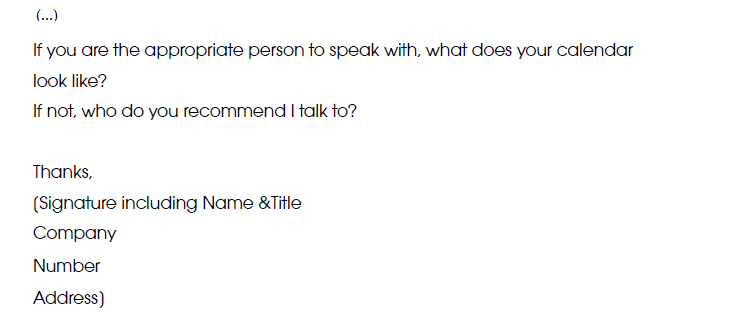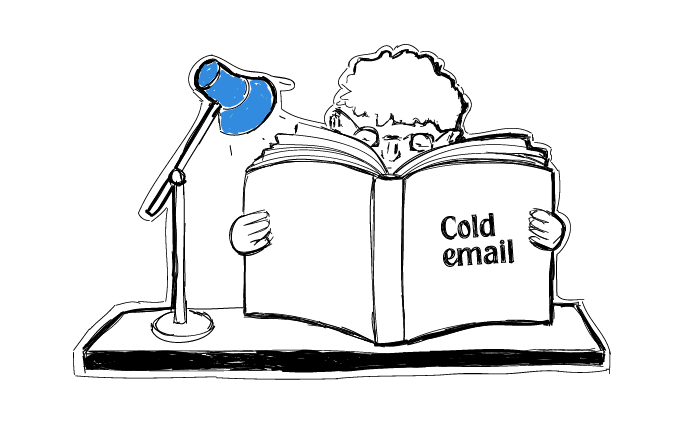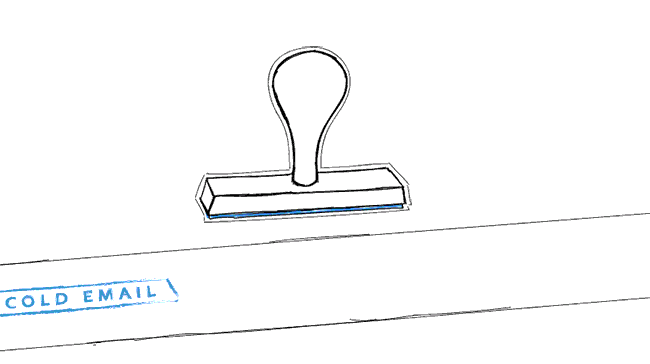If you’ve been into cold emails for some time, or if you get hundreds of cold emails into your inbox, you are probably able to quote some cliché phrases and structures showing up over and over again for years. I described just a few of them below. Check if you know them. Check if you use them. Check how to replace them, which may probably boost your reply rates.
What is this post for?
First things first: I do feel a strong urge to simply tell you:
Those structures simply got and worn-out, so stop using them! So many email senders have been using them that nobody cares anymore. When I see them in my inbox, my first impression of the person who’s trying to contact me drops way down in no time. And as a recipient of such messages, I usually can’t resist the need to press ‘Delete’ right away.
But that’s just me. That’s just my opinion. You can consider it, or not.
After all, it’s not about what I think or feel. It’s about what your prospects think and feel while reading your emails.
I don’t know your group of prospects. Nobody really does, except you. It’s you who should know them best.
You should know if they might get annoyed by the same email template coming from a 23rd company that’s been trying to contact them. Or maybe they don’t get that many cold emails after all, and even the well-known templates will still work for them. It’s for you to test and find out.
I’ve seen cold email campaigns that I would never expect to bring any positive results. And yet, they worked just fine for a specific group of prospects.
That’s why I want to make sure you correctly understand my motivation here. There are two reasons I decided to write this post, so…
Please share your thoughts with me
1. I’m wondering, if you also feel that some worn-out cold email pieces just don’t work anymore. Or maybe some of them still work for you. Either way, let me know in the comments under this post.
2. I’m curious about other examples of such cold email clichés. I’m going to mention just a few here, but I bet there are more of those and that each of us can think of at least one or two other than those below. Please share them in the comments section.
Ok, now we can move on to the clichés.
The “Appropriate person” – subject line, intro & CTA
This is mostly taken from the assumptions made years ago by the creators of methods like Predictable Revenue or Breakthrough Email. Although those frameworks may still work pretty great, the very email templates used within the frameworks have been sent so many times that they may simply get ignored nowadays.
The subject line:
“Appropriate person”
The intro:
“I am writing in hopes of finding the appropriate person who handles <XYZ>?”
The CTA:

Here’s how this works for me: when I see the subject line, I know right away what I’ll find inside. I know that I’m going to see a sales pitch. I know what they will expect me to do in the CTA. It feels like an old trick and I don’t want to get tricked, so my reflex is to ignore, or even delete, the email immediately.
Will this structure work in some cases? Maybe. I guess it could work, if your prospects are not very much into sales or marketing, and if they are not getting many cold emails. Or, if the pitch that is tailor-made for them got sent at just a perfect time, that is when they are actually looking for a solution like yours right now, I believe this one might work.
What to use instead?
Experiment with a different subject line. Keep it short, but try something more specific. I guess simply not copying the subject may help in this particular case.
If you do want to focus on finding the person, use different words at the very beginning. Adjust the tone to your prospect group. Ideally, add some personalization at the beginning to show the reason why you chose to contact those exact people and not someone else.
In the CTA, test out staying on emails for the first touch. Why ask about the calendar right away? Perhaps the first step would be to verify, if your addressee will get back to you to confirm that they are indeed the appropriate person to talk to. And maybe the second question could be a part of your follow-up? In this particular form, the CTA sound a bit like I’ve no choice: it’s either-or. This feels kind of pushy and some of your prospects may get annoyed by that.
Let-me-introduce-myself kind of an intro
This is probably the most common intro structure I see in the cold emails that get to my inbox. I guess it proves that many of us feel that if we’re writing to someone who doesn’t know us yet, the first thing to do is to introduce ourselves.
“My name is John and I work with…”
“My name is John and I’m a…”
“My name is John, my team and I …”
From my experience, the chances that someone reads on after such an intro are very poor. Think about the message here. The first thing that comes to one’s mind after reading those lines is: ok, I don’t know this person, this person doesn’t know me. So why should I actually read on?
What to use instead?
Instead of introducing yourself in the intro, you can make the intro about your prospect. Tell them why you chose to contact them. What did you find about them that made you send that email? Why did you choose them to reach out to instead of millions of other people?
If you want your prospects to read your email and reply, you want to get them thinking: ok, somebody actually noticed my work! This person actually did their homework before sending this email, she seems reliable, she’s not pushy, I could actually reply to this.
Just make sure you let them actually think about themselves and their company in the context of your value proposition. Don’t make them think about you in the context of your company. It may seem kind of selfish and irrelevant to them.
Check how I started a cold email that got 50% reply rate >>
Generic welcome one-liners
In short, these are generic lines we may put at the beginning of our message in order to seem more polite/nice/generous, or to excuse ourselves. Here are some examples:
“Hope this email finds you well!”
“I know you’re busy so I’ll keep this real short.”
“I decided to send you an email instead of calling you.”
One of the most crucial characteristics of an effective cold email is that it brings value to the recipient. Those lines don’t seem to bring any real value to me.
The first one is completely redundant – I don’t know what else I can tell about that. Seriously.
The second actually breaks the promise it’s trying to make – I just wasted my time reading a whole sentence which didn’t bring anything interesting to me and which could have been easily removed from the email that was supposed to be short.
The third one sounds like someone’s actually trying to show me that they did me a favor by sending the email – they could have called me, but they didn’t, so that’s why I should be grateful to them, or whatever. I feel like they want me to think “Why, thank you, for being so thoughtful and not trying to irritate me by calling me on the phone. How can I ever repay you for your kindness?” Well, that’s definitely not what I think after reading such a line at the beginning of a cold email.
But enough of the hate, what to write instead?
What to use instead?
Check if you can just remove the sentences that are redundant and bring perfectly nothing to your email – especially at the beginning of it, where you need to bring value in order to draw the recipient into the message. If you remove a sentence like that, and the email still reads ok, just do that. Basically, it’s always good to check, if your email copy can be reduced and still bring the same value. The shorter the email, the more digestible it looks and the greater the chances that your prospects will actually read it.
And again, you can replace the cliché with a piece of information about your prospect. Don’t tell them you care about their time – show them. Don’t tell them you took some time to dig information about them and find their email – show them. In cold email, it’s always better to show than to tell.
Worn out follow-ups
From my point of view, writing a valuable follow-up is even harder a task than writing a good opening message. I think that’s why many cold email senders look for shortcuts, and send some templates they’ve found on the web, like the “Alligator email”, described in this post by John Barrows.
Or, they send some short generic messages that don’t bring any new value at all.

Additionally, in this particular case, a follow-up got sent every three days, so:
No value + automatic-like sending sequence = how to increase your chances for getting an angry response, not a positive response (which is obviously not your goal).
Check What to Do When You See Negative Replies to Your Cold Emails? >>
What to use instead?
Recently, I answered a question about follow-ups on LinkedIn. It’s very close to what I wanted to write about follow-ups here and because it turned out to be a piece of helpful advice, let me quote it here:
“As to the content, in the follow-ups, you can show the same value from another perspective. For instance: if in the first email you refer to growing your prospect’s revenue, in the follow-up you can refer to saving time, or to avoiding losing money, or to growing their reputation.
These are just examples, I’m not sure what exactly your value proposition is and what you are trying to achieve with your cold email campaign in the long run. The key is to show your prospects various benefits, because some benefits will resonate better with one prospect, and some with another.
You can also change your CTA in the follow-ups. Perhaps your prospects won’t be eager to set up a chat, but they could answer a specific question via email. This could turn into an email exchange, and only after some time you could schedule a talk.
In sum, the process would be to: think about various benefits of your solution, think about various pain points your prospects may have, list them. Think about various ways to connect with your prospects: a chat may be your goal, but you don’t have to achieve it after just one email – it’s all about starting a conversation.
Then, come up with some follow-up versions and put them in a logical order in your sequence. Test, conclude, adjust, test some more, and so on.
Hope this helps a bit.”
In sum, your follow-ups should bring new value to the prospects or present another perspective on something that may be valuable to them.
And regarding the “Alligator email”, you can of course put some humor into the follow-ups. Just make sure it fits the tone of your previous messages. But refrain from copying and pasting funny follow-up templates from the web. It’s like telling the same old jokes everyone heard at least three times, so they won’t be even trying to smile politely after hearing the joke again. Being truly funny in a follow-up email can be very effective, but it’s also very difficult.
What’s in it for you?
1) If you’re using such well-worn phrases and structures in your cold emails, try to replace them and measure the effects. Probably the best way to do that is A/B testing. Create another version of your campaign in which you’re going to replace the clichés with other phrases that you craft yourself. You won’t know what works and what doesn’t, if you don’t test.
2) If you’re planning your campaign right now, don’t look for shortcuts. Think about your prospect group, verbalize the real value your product or service can bring to the prospects. Brainstorm, write down a few versions. Cut the copy to make it shorter, remove the redundant parts.
If you really like some templates that you’ve found on the web, don’t copy them! Instead, try to analyze them and define what makes them work. Then, try to employ the mechanisms (and not to include the very words and phrases) into your own, unique email copy.
Hope this helps. I’ll appreciate it very much if you share with me your thoughts on the two points I mentioned at the beginning of this post.
READ ALSO

10 Factors that Make Our Cold Emails Work (or Not)
If you're sending cold emails, you know that sometimes your messages work amazingly well, sometimes they work OK, and sometimes they don't work at all. And whether your outreach works great, or it hardly works at all, there's always a reason for that. Actually, in most cases, there's a whole collection of reasons for that. Here's a list of 10 factors that you may want to check to discover the cause of your campaign's success or failure, and to improve the effectiveness of your emails in general.

A Comprehensive Guide to Cold Email
This week we have a little special. I've been writing about cold emails for over 2 years. Last week I realized that I've written over 100 posts on this blog so far. That's a lot of material. So this week I decided to prepare a kind of a table of contents, so you have a place on this blog where you can easily and quickly find what you're looking for. Plus, maybe it will allow you to discover some posts you haven't read before. Check out the collection that makes a comprehensive guide to cold email.

3 Resources that Will Help You Ask Better Questions
Sales articles are full of advice on how to skilfully ask questions during sales interview. That's not surprising. Questions are the exact thing that helps us move potential leads through the sales funnel. Cold callers use them during discovery calls and those who prospect might use questions while looking for the ICPs. But how to apply it to cold email senders who have just begun the conversation? Here I gathered 3 resources that will help you learn how to perfect the art of asking questions.

